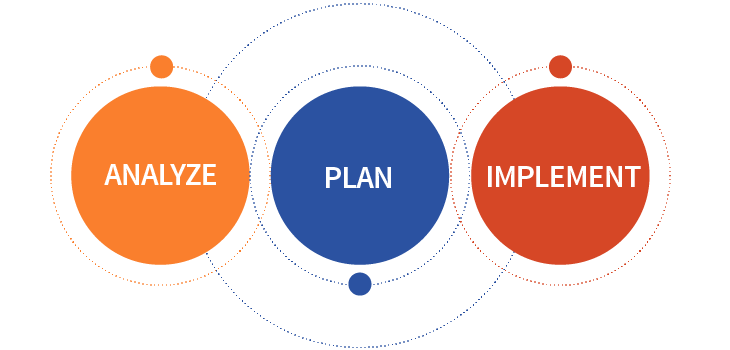Replacing Old Tech
1. Gather Your Specs
Collect any documentation you have on your existing lightning warning system, including the number of sirens and where they are located at your facility. Providing this information up front to any new vendors will help streamline the process of replacing the system.
2. Determine Your Requirements
We recommend a 3-stage process for purchasing a weather safety solution. Analyze, Plan, and Implement. In the Analyze phase, you gather requirements and do some research into what exactly your weather safety challenges and needs are. In the Plan phase, you take the information from the previous stage to build out (or update) your weather safety plan and procedures, including details on any weather technology you need to support your plan. In the final stage, Implement, you identify and install the required technology, test the system, and educate your staff and visitors on how the new technology works so they will be prepared for the next severe weather event.
3. Assess the Market Place
The vendor that sold your old system may no longer produce that product. There may also be newer players in the field or vendors with more advanced technology. Make sure you check to see what’s new on the market before replacing an old system.
4. Choose Top Vendors and Evaluate
The next step in this process is to select your top vendors – those that most closely align with your requirements – and contact them to begin the evaluation process. This will include exploratory phone calls, demos, and possibly an on-site visit to help you select the vendor that will best meet your needs.
Deploying New Tech
Are you starting from scratch? Not to worry. The steps you follow when deploying new weather safety technology will be similar to replacing an old system with a few exceptions.
Start with A-P-I
First, you may not have specifications (number of lightning sirens, locations, etc.) on hand and will need to work with your selected vendor to outline those specifications. This means you will need to start with the 3-stage process we recommend above (Analyze – Plan – Implement) and then circle back to the specifications later in the process.

Phone a Friend
Second, we recommend that you consult with other government agencies, like your local emergency management agency, to see if they work with any vendors that they would recommend. They may already be working with a preferred weather vendor or will have worked with one in the past.
Tech in Your Weather Safety Toolkit
Most parks and recreation facilities build up their weather safety toolkit with some combination of the following:
1. Lightning Alert Siren & Strobe System
2. Real-time Weather Map & Mobile App
3. On-site Weather Station
4. Custom, On-Demand Forecasting Support
5. Information Displays
Installing the right weather monitoring and alerting technology for your facility is only the starting point. Once the technology is in place, you need to know which tools to use when. We’ve identified 4 stages of a weather event to be mindful of:
MONITORING – Before the Storm Arrives
ALERTING – Once the Storm Reaches a Critical Radius
UNDER ALERT – Once the Storm Poses an Imminent Threat and Action is Required
ALL-CLEAR – Once the Storm has Passed and it is Safe to Resume Activities
Using a system with that fully supports these four stages ensures total coverage before,
during, and after a dangerous weather event.
Up Next: Lightning Alert Siren & Strobe
👇 Continue Reading this Guide👇



